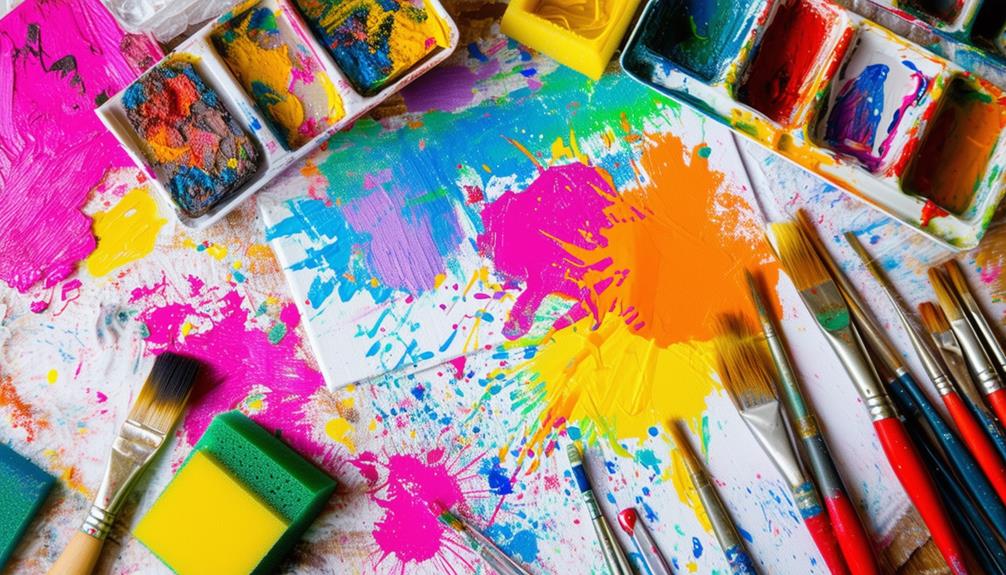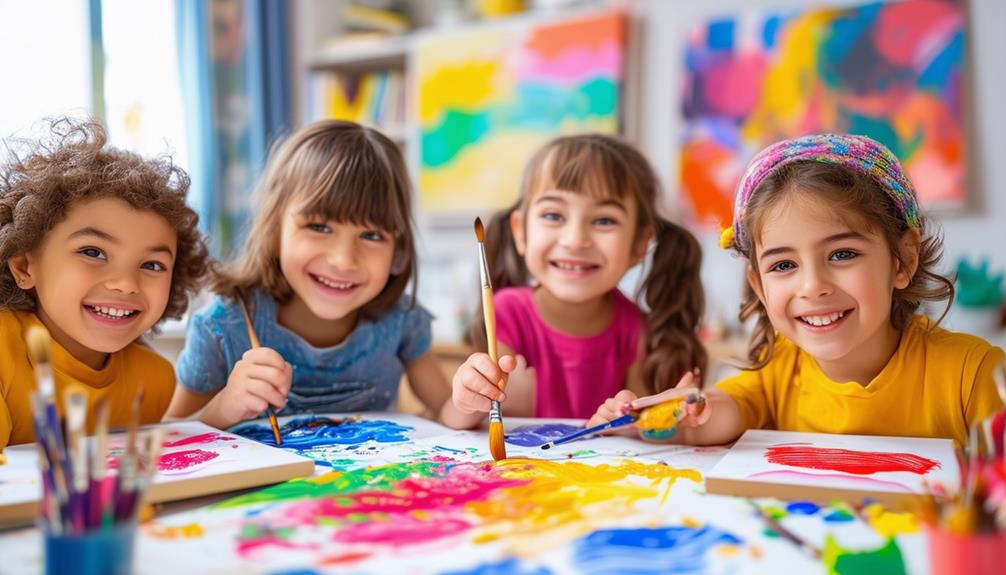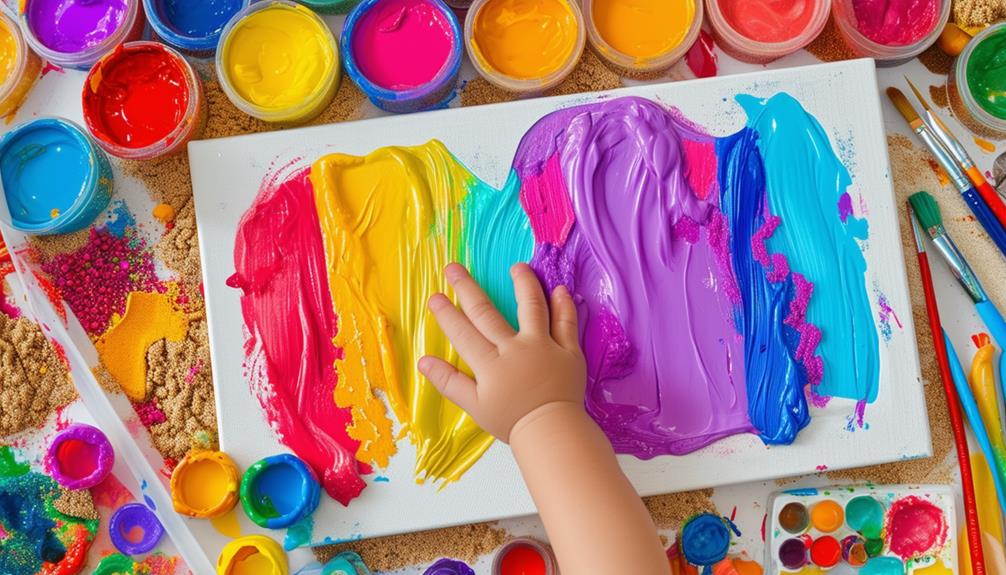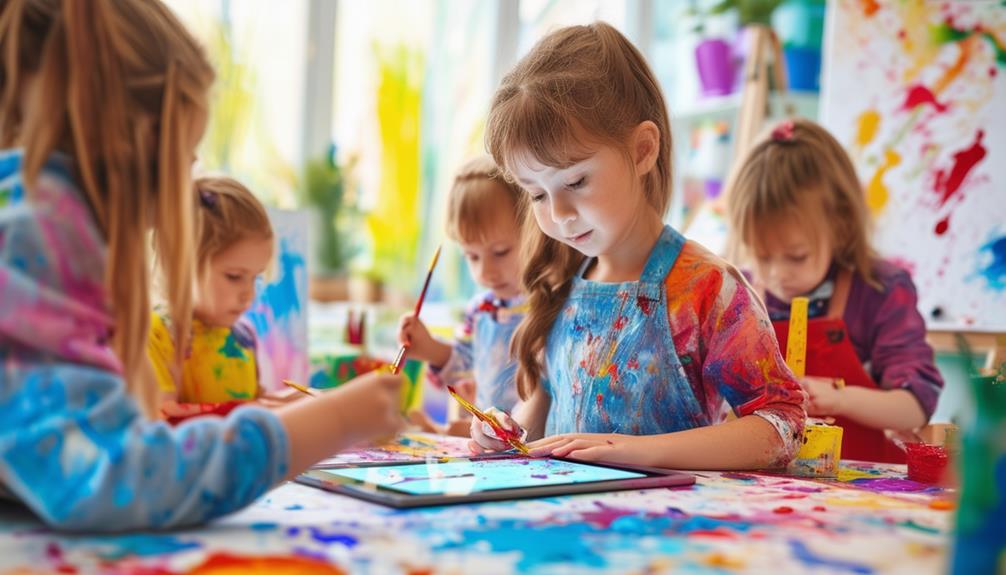The Role of Painting in Developing Hand-Eye Coordination
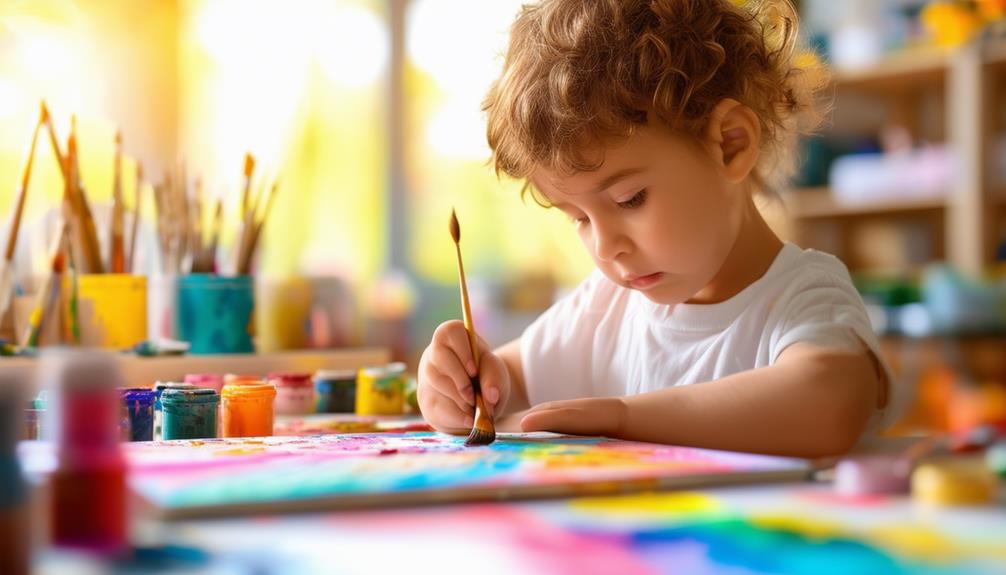
When considering ways to develop hand-eye coordination, painting should not be overlooked. The act of translating visual information onto a canvas with precise brush strokes requires substantial control and synchronization between the eyes and hands. Practicing various painting techniques can enhance fine motor skills and visual perception, benefiting not only artistic abilities but also overall dexterity. Interested in how these elements enhance coordination? Let's explore why painting is uniquely valuable in this regard.
Importance of Hand-Eye Coordination
Hand-eye coordination is crucial as it enables the translation of visual information into precise physical actions, whether you're painting or performing surgery. When painting, fine motor control is essential for creating detailed strokes and shapes, thereby enhancing hand-eye coordination by focusing on visual details and executing exact movements. This precision is not only vital for art but also for developing a fundamental skill that influences many aspects of life.
The importance of skill development in hand-eye coordination cannot be overstated. Both artists and surgeons exhibit similar eye movement patterns while working, underscoring the necessity of training the eyes and hands to function harmoniously. Eye-tracking studies demonstrate that these professionals frequently shift their gaze to gather visual data and make precise adjustments.
Furthermore, insights from hand-eye coordination are advancing robotics. By studying how humans coordinate their eyes and hands, engineers can develop more sophisticated robotic systems capable of performing intricate tasks. Thus, practicing painting is not just an artistic endeavor; it also contributes to personal skill development and technological innovation.
Painting Techniques for Beginners
Begin by practicing basic brush strokes to understand how paint interacts with the canvas. Experiment with color mixing to create various hues and shades. Explore simple composition ideas to effectively organize your artwork. Focusing on these foundational techniques will help you build essential skills for more complex projects.
Basic Brush Strokes
Mastering basic brush strokes like the flat brush stroke, round brush stroke, cross-hatching, and dry brushing is essential for any beginner in painting. These techniques are crucial because they help develop your hand-eye coordination, making your artwork more accurate and expressive. By learning to control brush pressure, angle, and speed, you can execute different brush strokes effectively, adding depth and dimension to your work.
- Flat Brush Stroke: Ideal for filling in large areas and creating straight, bold lines.
- Round Brush Stroke: Perfect for detailed work and creating smooth, flowing lines.
- Cross-Hatching: Excellent for shading techniques and adding texture.
- Dry Brushing: Useful for creating texture and a sense of movement.
Practicing these basic brush strokes allows you to experiment with texture, shading, and defining shapes. The flat brush stroke helps cover broad areas quickly, while the round brush stroke lets you focus on finer details. Cross-hatching and dry brushing add complexity and interest to your pieces. Mastering these strokes will enable you to express your unique style and improve your painting skills effectively.
Color Mixing Tips
Mastering color mixing techniques is essential for beginners aiming to create dynamic and harmonious paintings. Start by familiarizing yourself with the basics of color theory. The primary colors—red, blue, and yellow—serve as your foundational building blocks. By mixing these, you can create secondary colors such as orange, green, and purple. Experiment with different ratios to observe how variations yield different hues.
A color wheel is an invaluable tool for beginners. It visually represents color relationships and aids in creating balanced compositions. Use it to understand which colors complement each other and how to avoid clashing combinations.
Creating tints and shades is another fundamental aspect. Gradually add white to a color to create tints, resulting in lighter shades. Conversely, adding black will produce deeper, richer tones known as shades. This practice will enhance the depth and dimension of your paintings.
Don't hesitate to experiment. The more you practice, the better you'll understand how colors interact. Hands-on experience is vital for developing your skills and building confidence. With time, you'll master the art of color mixing and create visually stunning pieces.
Simple Composition Ideas
Beginning with simple composition concepts like still life setups or basic geometric patterns can significantly improve your hand-eye coordination in painting. For beginners, focusing on these straightforward compositions helps establish a solid foundation. By practicing these techniques, you'll become more comfortable with your brushstrokes, color choices, and surface textures.
Here are some simple ideas to start your journey:
- Still Life Setups: Arrange common objects such as fruits, containers, or flowers. This helps you focus on shapes, shadows, and lighting.
- Geometric Designs: Create patterns using basic shapes like circles, squares, and triangles. This is useful for enhancing precision and control.
- Monochromatic Palettes: Use different shades of a single color to better understand value and contrast.
- Abstract Art: Experiment freely with colors and textures to find your artistic voice without worrying about realism.
Fine Motor Skills Development
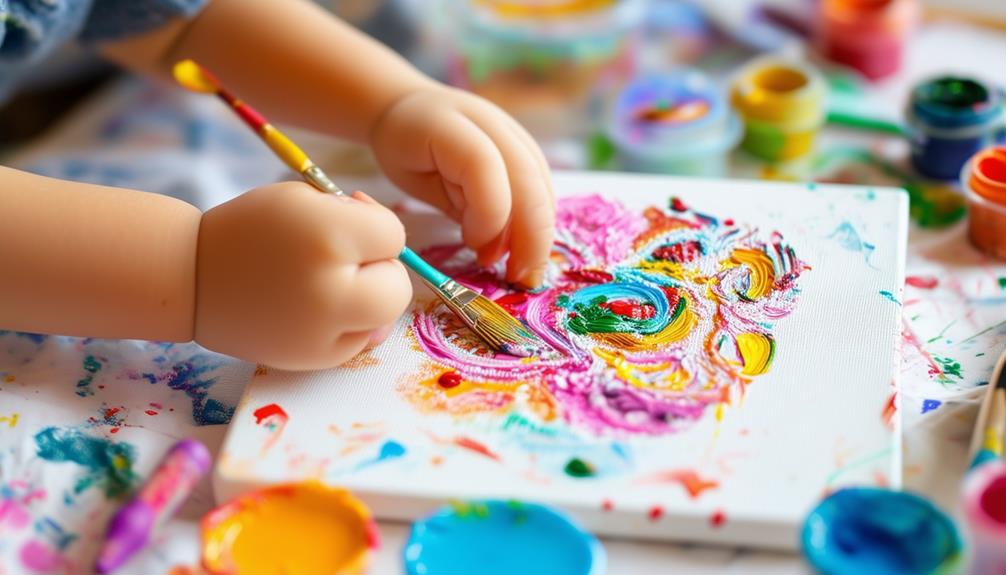
Engaging in painting activities is an excellent way to strengthen the hand and finger muscles, essential for developing fine motor skills. Painting improves hand-eye coordination through precise movements, aiding in better control over small actions necessary for tasks like writing or buttoning a shirt.
Focusing on brush strokes and artwork details naturally enhances concentration and attention to detail, crucial for both art and everyday tasks requiring high focus. The repetitive motion of painting also improves tactile perception, increasing awareness of textures and pressures applied by the hand and fingers.
Regular painting practice further develops fine motor skills, making intricate and delicate movements more efficient and less prone to fatigue. So, when you pick up a paintbrush, remember that you're not just creating art; you're also honing fundamental skills for daily life.
Visual Perception and Painting
When you paint, you enhance your visual processing by interpreting colors, shapes, and spatial relationships. Coordinating your visual and motor skills allows you to accurately translate your observations onto the canvas. This practice also strengthens cognitive functions, as your brain continuously integrates sensory information with motor actions.
Enhancing Visual Processing
Understanding how artists process visual information can greatly enhance their hand-eye coordination and painting abilities. When you paint, your brain is actively engaged in visual processing, which includes interpreting sensory input, utilizing memory and experience, and employing fine motor skills. The fovea, rich in cones, is crucial for focusing on details and enhancing your perception of colors and shapes.
Memory and experience are essential for filling in gaps in visual information, enabling your brain to predict and interpret what you see. This mental process directly impacts your hand-eye coordination, making your brushstrokes more precise and intentional. Additionally, strengthening your hand muscles through regular practice contributes to better control and fluidity in your movements.
Engaging in painting offers numerous benefits, such as:
- Improving fine motor skills: Repeated brush movements refine your control over small hand muscles.
- Enhancing hand-eye coordination: Your eyes and hands work together, improving your ability to translate what you see onto the canvas.
- Rich sensory experiences: Different textures, colors, and techniques stimulate your senses, enriching your creative process.
- Emotional expression: Painting provides a therapeutic and fulfilling outlet for channeling your emotions into your art.
Coordinating Visual and Motor Skills
Building on the enhancement of visual processing, integrating visual perception with motor skills is essential for translating observations into precise and expressive brushstrokes. During painting, hand-eye coordination is crucial, requiring the eyes and hands to work in harmony. This synchronization enables artists to accurately represent their subjects, effectively transferring what they see onto the canvas.
Eye-tracking studies reveal that both artists and surgeons depend heavily on precise hand-eye coordination. For artists, it involves blending colors and creating intricate designs. For surgeons, it means executing exact incisions and delicate maneuvers. This shared reliance underscores the vital role of visual processing and motor skills in diverse disciplines.
Over time, memory and experience enhance this coordination by bridging visual gaps during painting, making actions more fluid and accurate. Notably, understanding these parallels can advance robotic technology. By examining how artists and surgeons coordinate their hand-eye movements, developers can create more sophisticated robots that emulate these skills, thereby improving both artistic and surgical outcomes.
Strengthening Cognitive Functions
Painting significantly enhances visual perception by training your brain to interpret and process visual information more effectively. Engaging in painting isn't just about creating art; it's also about improving crucial cognitive functions. Focusing on intricate details and shapes sharpens your brain's ability to process visual data, which is vital for developing better hand-eye coordination.
Consider these benefits:
- Enhanced spatial awareness: Painting helps you understand how objects relate to each other in space.
- Improved depth perception: Working with perspectives trains your brain to judge distances and depths more accurately.
- Boosted visual processing: Painting stimulates your brain's visual centers, enhancing your ability to interpret complex visual stimuli.
- Strengthened cognitive functions: Regular painting exercises essential brain functions, improving mental agility.
Benefits of Regular Practice
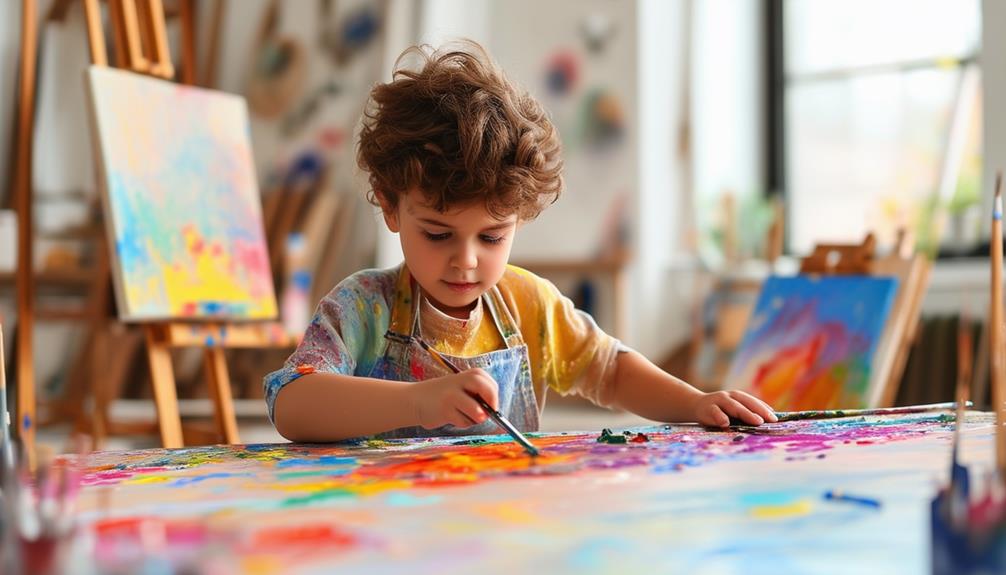
Engaging in regular painting practice significantly enhances hand-eye coordination and fine motor skills. Each brushstroke requires precise movements, thereby strengthening your hand and finger muscles. This improvement in coordination and motor skills is a direct result of the consistent, detailed work involved in painting.
Painting also sharpens both tactile and depth perception. By mixing colors and applying them to a canvas, you become more attuned to various textures and spatial relationships between objects. This increased awareness enhances your overall spatial perception.
Moreover, painting demands intense focus and concentration. As you work on intricate details, you train your mind to stay attentive and engaged, which can positively impact your ability to concentrate on other tasks in your daily life. This practice not only improves your concentration but also refines your visual processing skills, aiding in better interpretation of visual information.
Tools and Materials Needed
To harness the benefits of painting for hand-eye coordination, you need the right tools and materials. These supplies will make the process enjoyable and improve your skills effectively. Here are the essential items to consider:
- Brushes: Different types such as round, flat, and filbert brushes are crucial for various painting techniques. They help achieve diverse strokes and textures, aiding in the development of fine motor skills.
- Paints: Quality paints like acrylics, oils, and watercolors each offer distinct textures and finishes. Acrylics dry quickly for faster layering, oils provide rich, vibrant colors but dry slowly, and watercolors are excellent for soft, fluid effects.
- Canvases: Available in various sizes and materials like cotton, linen, and synthetic fibers, the choice of canvas impacts the texture and appearance of your painting.
- Workspace: Ensure your workspace has proper lighting and ventilation. A comfortable environment helps you focus, enhancing the development of your hand-eye coordination.
Investing in these tools and materials will set you up for a successful and fulfilling painting experience.
Encouraging Creativity Through Art

Fostering creativity in children can be as simple as providing them with the tools and freedom to explore their artistic instincts. Encouraging them to engage in art opens a world where they can express their ideas and thoughts freely. Painting, in particular, offers a unique medium that stimulates their imagination and allows them to bring their inner visions to life.
When children paint, they are not merely applying colors to a canvas; they are experimenting with new ways to communicate and think. This process helps develop their creativity by pushing the boundaries of their imagination. Through painting, kids learn to interpret the world around them and translate those perceptions into visual forms.
Incorporating art into your child's routine can foster an environment where creativity thrives. Provide them with a variety of materials and a space where they can create without restrictions. This freedom allows them to experiment and explore their personal style. As they express their thoughts and ideas through painting, they develop their creative skills, problem-solving abilities, and critical thinking. Ultimately, art is not just about creating beautiful pictures; it's about nurturing a child's ability to innovate and think creatively in all aspects of their life.
Comparing Painting to Other Activities
Comparing painting to other activities reveals surprising similarities, such as the steady hands and sharp eyes required in both painting and surgery. When you paint, you develop fine motor skills and hand-eye coordination, much like a surgeon performing delicate operations. Both activities demand precision, control, and the ability to interpret visual information.
Interestingly, eye-tracking studies have shown that artists and surgeons share similar eye movement patterns, indicating a strong link between these seemingly different tasks. This connection underscores the cognitive and emotional benefits of engaging in art activities. Here are a few activities that also foster motor skills development and share common ground with painting:
- Sculpting: Enhances fine motor skills and creativity while requiring precise hand movements.
- Playing musical instruments: Develops hand-eye coordination and precision, akin to the control needed in painting.
- Drawing: Shares the same creativity and focus on detail and accuracy as painting.
- Cooking: Involves careful hand movements and attention to detail, similar to the techniques used in painting.
Engaging in these activities not only boosts motor skills but also improves cognitive and emotional well-being, making them valuable pursuits alongside painting.
Tips for Parents and Teachers

Parents and teachers can play a pivotal role in enhancing children's hand-eye coordination by incorporating diverse painting activities into their routines. Here are some effective tips to help you get started:
- Diverse Tools: Utilize various painting tools such as brushes, sponges, and fingers to enrich fine motor skills.
- Mixed Media: Combine painting with other activities like drawing or crafting to keep the experience engaging.
- Regular Practice: Consistent practice is key to developing better coordination over time.
- Fun Environment: Ensure that painting activities are enjoyable to keep children motivated and interested.
- Process Over Perfection: Focus on the activity itself rather than the end result to encourage exploration and learning.
Here's a quick guide to help you plan painting activities:
| Activity | Tools Needed | Skills Developed |
|---|---|---|
| Finger Painting | Non-toxic paints | Fine motor skills |
| Brush Painting | Brushes of various sizes | Precision, hand-eye coordination |
| Sponge Painting | Sponges, paint | Texture exploration |
| Stamping | Stamps, ink pads | Pattern recognition |
| Mixed Media | Paint, collage items | Creativity, coordination |

